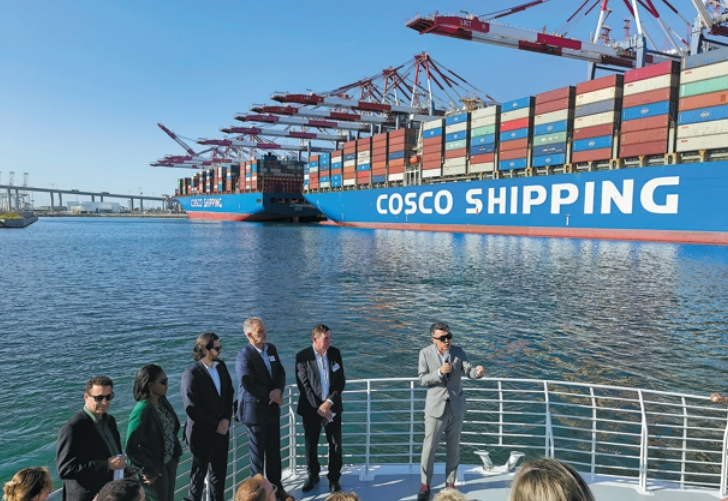
Ports join hands in building sustainable shipping corridor
LOS ANGELES : Two large COSCO cargo ships filled with containers were anchored at the bustling Port of Long Beach, south of downtown Los Angeles, standing out prominently on the vast ocean and highlighting the scale and significance of international trade.
The Long Beach port, one of the busiest in the world, serves as a critical gateway for goods entering and leaving the United States, particularly from Asia.
“We’re the second-busiest port in America after LA … (collectively) the ninth-largest port complex in the world, and we’re proud to be in a partnership with Shanghai, the largest container port in the world,” Joel Perler, the Port’s Economic Development Manager, told China Daily at a side event of the Select LA Investment Summit on Thursday in Long Beach.
The Port of LA and the Port of LB comprise the San Pedro Bay port complex, handling almost 19 million 20-foot equivalent unit containers each year. Asia is their top foreign trade route, with China being the leading trading partner, according to LA port statistics.
Felipe Cusnir, Executive Director of World Trade Center Long Beach, said the collaboration with China is particularly important for the port complex.
He highlighted efforts to promote green shipping by lobbying for incentives that encourage shipping companies to adopt more sustainable practices.
“This way, we get more shipping plans to commit to serving the Chinese market and the American market through the ports,” he said.
In September, the Shanghai Port-Los Angeles Port Green Shipping Corridor Implementation Plan Outline was launched, establishing the world’s first trans-Pacific green shipping corridor for one of the busiest trade routes.
Starting next year, shipping company partners will deploy vessels capable of full life cycle low-carbon or zero-carbon emissions along the corridor. The aim is to demonstrate the feasibility of the world’s first full life cycle zero-carbon emission container ship on this route by 2030.
Members of the C40 Cities Climate Leadership Group attended a workshop in Shanghai last week to explore global climate solutions for zero-emission trans-Pacific container shipping.
“They negotiate incentives for shipping lines to receive benefits,” Cusnir said. “This could include discounts on shipping rates if they’re using green fuels or connecting to electricity instead of running on diesel generators.”
Supply chain resilience and adaptability have undergone various challenges over the past years. The trade wars during former US president Donald Trump’s administration led to shifting cargo volumes, reducing them to below-normal levels in 2019.
In 2020, the pandemic caused another shift, with a focus on workforce protections and coordination. Despite such challenges and present tariffs on Chinese imports, there is still a strong demand for Chinese products in the US, Cusnir said.
Manufacturing center
“We’re going to continue trading for Chinese products to access the US because Americans like to consume, and China is an amazing manufacturing center that continues to provide a lot of goods to the US, and we don’t see any supply chain going away.”
At Thursday’s annual summit, speakers discussed the challenges and opportunities faced by the ports, emphasizing their focus on technology and sustainability, with a goal of achieving zero-emission cargo handling equipment and trucks by 2030.
While large cargo volumes have come through the complex every year, the ports are focusing on increasing volume in line with projections for a green shipping corridor and infrastructure, Avin Sharma, senior director of workforce and government affairs at the Port of LA, said.
Nancy Sutley, deputy mayor of LA, and the Port of LA’s Executive Director Eugene Seroka also attended the Shanghai workshop last week to find solutions for alternative marine fuels.
Reducing emissions by just 10 percent on the route from the Port of Shanghai to the Port of LA equates to the total emissions in LA over a year, Sharma said.
“As the economies of both countries remain strong, and consumers continue to purchase import-export products, the route between Shanghai and LA, as well as other ports in the Pearl River Delta and surrounding areas, will continue to be important.”
A $760 million budget has been approved for the Port of Long Beach for fiscal year 2025, establishing a plan to fund new capital improvements in rail, zero emissions and other infrastructure.
Casey Hehr, managing director of commercial services at the Port of LB, said the port is working closely with Shanghai on a green shipping corridor.
“The cargo volume from China has increased … 5 to 10 percent over the previous year,” Hehr said. “We continue to push forward on trade corridors between Shanghai and Long Beach.”
Regarding sustainability, clean technology and green infrastructure, Allison Clark, vice-president of business and international trade development at the Los Angeles County Economic Development Corporation, emphasized the importance of collaboration with China to create green shipping corridors.
“It’s vitally, vitally important for our ports to work with China on this plan,” she said. “The agreement is paving the way for collaboration with other countries, making it a wonderful example.”
Source : China Daily
